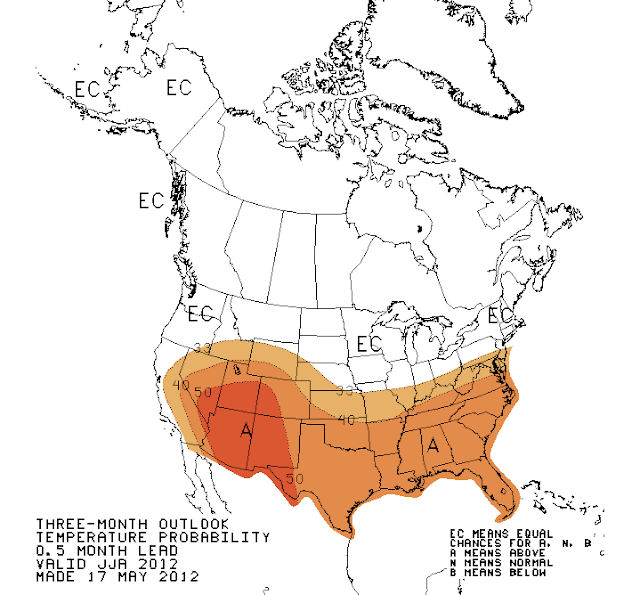Several reports have come out recently about a forecast for an unusually hot Summer across a large part of the U.S., but seasonal forecasts can be tricky to interpret. The Climate Prediction Center, which issues long range forecasts, does not typically outright call for above or below normal temperatures or precipitation in seasonal outlooks. Rather, these outlooks are probabilistic in nature, meaning they refer to the chances of a hotter or colder and drier or wetter season. Below is the temperature outlook for June, July and August, which makes up the meteorological Summer season.
At first glance, it appears that the Climate Prediction Center is showing above average temperatures for most of the Southern half of the Country, but that is not really what the graphic shows. See the numbers along the lines, such as 33, 40 and 50? These represent probabilities, not temperatures or temperature anomalies. The orange area represents a probability of greater than 33% of a warmer than average Summer. The white area represents Equal Chances, that is what the "EC" stands for. This does not mean a forecast for an average Summer, but rather that the chances of a hotter, cooler, or normal Summer are all the same. Notice that much of the Southeast is in the 40 to 50 range for the probability of a warmer than average Summer, which means the combined chance for an average or below average summer is still over 50%! Parts of the Southwest are in the over 50% probability area, which means the combined chance of an average or below average Summer are less than half. In this case the forecast is directly for a warmer than average Summer, but the area is relatively limited.
According to the forecast, Arkansas has just over a 40% chance of warmer than average Summer. The graph below breaks down the probability distribution for the region than includes Central and Southern Arkansas as well as Northern Louisiana.
There is a lot of information in the graph, but what it means is that the chance of a warmer than average Summer calculates to 42.2% based on the forecast. The chance of an average Summer is 34.4% and the chance of a cooler than average Summer is 23.2%. The combined chance of an average OR below average Summer is 57.8%. If I told you there is a 58% chance that the Summer will NOT be hotter than average, would you interpret that as me saying I expect hotter Summer than average? I didn't think so! This is the nature of probabilistic forecasting, though. There is so much uncertainty in long range forecasting it is necessary to communicate the confidence level of the forecast.
The outlook for Summer precipitation is even less clear, with equal chances of a dry, wet or average Summer all near equal chances for most of the Country, with only a somewhat higher than average chance of a dry Summer for the Northwestern U.S.



No comments:
Post a Comment